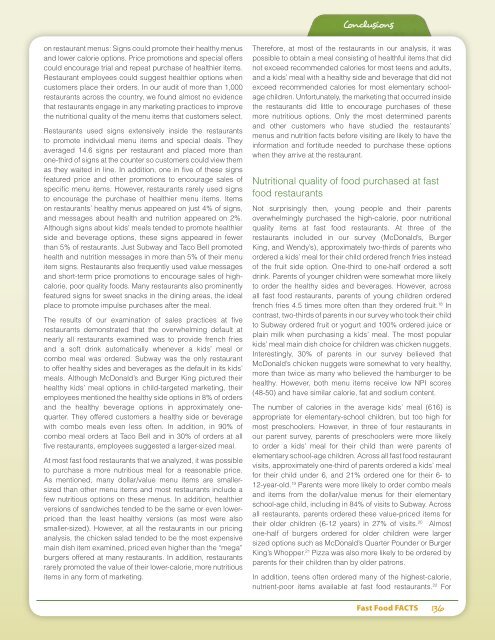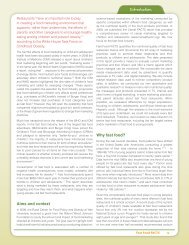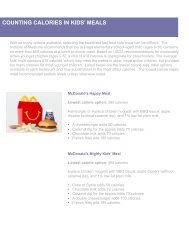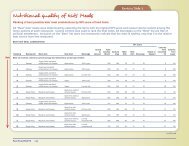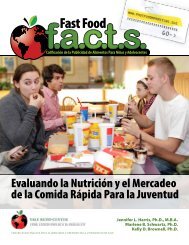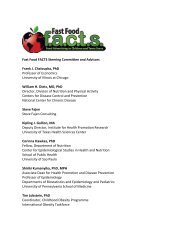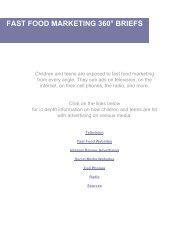Menu composition - Fast Food FACTS
Menu composition - Fast Food FACTS
Menu composition - Fast Food FACTS
Create successful ePaper yourself
Turn your PDF publications into a flip-book with our unique Google optimized e-Paper software.
on restaurant menus: Signs could promote their healthy menus<br />
and lower calorie options. Price promotions and special offers<br />
could encourage trial and repeat purchase of healthier items.<br />
Restaurant employees could suggest healthier options when<br />
customers place their orders. In our audit of more than 1,000<br />
restaurants across the country, we found almost no evidence<br />
that restaurants engage in any marketing practices to improve<br />
the nutritional quality of the menu items that customers select.<br />
Restaurants used signs extensively inside the restaurants<br />
to promote individual menu items and special deals. They<br />
averaged 14.6 signs per restaurant and placed more than<br />
one-third of signs at the counter so customers could view them<br />
as they waited in line. In addition, one in five of these signs<br />
featured price and other promotions to encourage sales of<br />
specific menu items. However, restaurants rarely used signs<br />
to encourage the purchase of healthier menu items. Items<br />
on restaurants’ healthy menus appeared on just 4% of signs,<br />
and messages about health and nutrition appeared on 2%.<br />
Although signs about kids’ meals tended to promote healthier<br />
side and beverage options, these signs appeared in fewer<br />
than 5% of restaurants. Just Subway and Taco Bell promoted<br />
health and nutrition messages in more than 5% of their menu<br />
item signs. Restaurants also frequently used value messages<br />
and short-term price promotions to encourage sales of highcalorie,<br />
poor quality foods. Many restaurants also prominently<br />
featured signs for sweet snacks in the dining areas, the ideal<br />
place to promote impulse purchases after the meal.<br />
The results of our examination of sales practices at five<br />
restaurants demonstrated that the overwhelming default at<br />
nearly all restaurants examined was to provide french fries<br />
and a soft drink automatically whenever a kids’ meal or<br />
combo meal was ordered. Subway was the only restaurant<br />
to offer healthy sides and beverages as the default in its kids’<br />
meals. Although McDonald’s and Burger King pictured their<br />
healthy kids’ meal options in child-targeted marketing, their<br />
employees mentioned the healthy side options in 8% of orders<br />
and the healthy beverage options in approximately onequarter.<br />
They offered customers a healthy side or beverage<br />
with combo meals even less often. In addition, in 90% of<br />
combo meal orders at Taco Bell and in 30% of orders at all<br />
five restaurants, employees suggested a larger-sized meal.<br />
At most fast food restaurants that we analyzed, it was possible<br />
to purchase a more nutritious meal for a reasonable price.<br />
As mentioned, many dollar/value menu items are smallersized<br />
than other menu items and most restaurants include a<br />
few nutritious options on these menus. In addition, healthier<br />
versions of sandwiches tended to be the same or even lowerpriced<br />
than the least healthy versions (as most were also<br />
smaller-sized). However, at all the restaurants in our pricing<br />
analysis, the chicken salad tended to be the most expensive<br />
main dish item examined, priced even higher than the “mega”<br />
burgers offered at many restaurants. In addition, restaurants<br />
rarely promoted the value of their lower-calorie, more nutritious<br />
items in any form of marketing.<br />
Conclusions<br />
Therefore, at most of the restaurants in our analysis, it was<br />
possible to obtain a meal consisting of healthful items that did<br />
not exceed recommended calories for most teens and adults,<br />
and a kids’ meal with a healthy side and beverage that did not<br />
exceed recommended calories for most elementary schoolage<br />
children. Unfortunately, the marketing that occurred inside<br />
the restaurants did little to encourage purchases of these<br />
more nutritious options. Only the most determined parents<br />
and other customers who have studied the restaurants’<br />
menus and nutrition facts before visiting are likely to have the<br />
information and fortitude needed to purchase these options<br />
when they arrive at the restaurant.<br />
Nutritional quality of food purchased at fast<br />
food restaurants<br />
Not surprisingly then, young people and their parents<br />
overwhelmingly purchased the high-calorie, poor nutritional<br />
quality items at fast food restaurants. At three of the<br />
restaurants included in our survey (McDonald’s, Burger<br />
King, and Wendy’s), approximately two-thirds of parents who<br />
ordered a kids’ meal for their child ordered french fries instead<br />
of the fruit side option. One-third to one-half ordered a soft<br />
drink. Parents of younger children were somewhat more likely<br />
to order the healthy sides and beverages. However, across<br />
all fast food restaurants, parents of young children ordered<br />
french fries 4.5 times more often than they ordered fruit. 18 In<br />
contrast, two-thirds of parents in our survey who took their child<br />
to Subway ordered fruit or yogurt and 100% ordered juice or<br />
plain milk when purchasing a kids’ meal. The most popular<br />
kids’ meal main dish choice for children was chicken nuggets.<br />
Interestingly, 30% of parents in our survey believed that<br />
McDonald’s chicken nuggets were somewhat to very healthy,<br />
more than twice as many who believed the hamburger to be<br />
healthy. However, both menu items receive low NPI scores<br />
(48-50) and have similar calorie, fat and sodium content.<br />
The number of calories in the average kids’ meal (616) is<br />
appropriate for elementary-school children, but too high for<br />
most preschoolers. However, in three of four restaurants in<br />
our parent survey, parents of preschoolers were more likely<br />
to order a kids’ meal for their child than were parents of<br />
elementary school-age children. Across all fast food restaurant<br />
visits, approximately one-third of parents ordered a kids’ meal<br />
for their child under 6, and 21% ordered one for their 6- to<br />
12-year-old. 19 Parents were more likely to order combo meals<br />
and items from the dollar/value menus for their elementary<br />
school-age child, including in 84% of visits to Subway. Across<br />
all restaurants, parents ordered these value-priced items for<br />
their older children (6-12 years) in 27% of visits. 20 Almost<br />
one-half of burgers ordered for older children were larger<br />
sized options such as McDonald’s Quarter Pounder or Burger<br />
King’s Whopper. 21 Pizza was also more likely to be ordered by<br />
parents for their children than by older patrons.<br />
In addition, teens often ordered many of the highest-calorie,<br />
nutrient-poor items available at fast food restaurants. 22 For<br />
<strong>Fast</strong> <strong>Food</strong> <strong>FACTS</strong> 136


